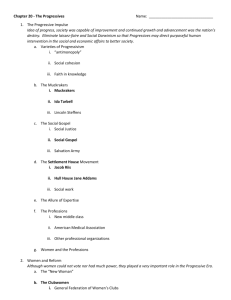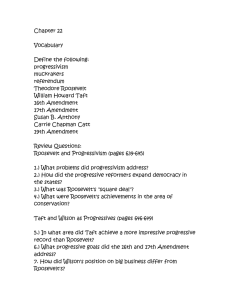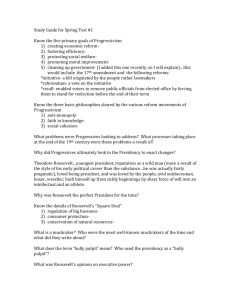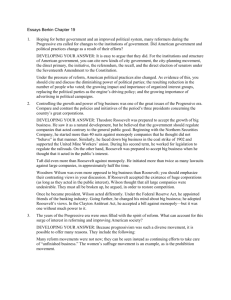APAH Reading Guide Name: Chapter 20 Directions – After reading
advertisement
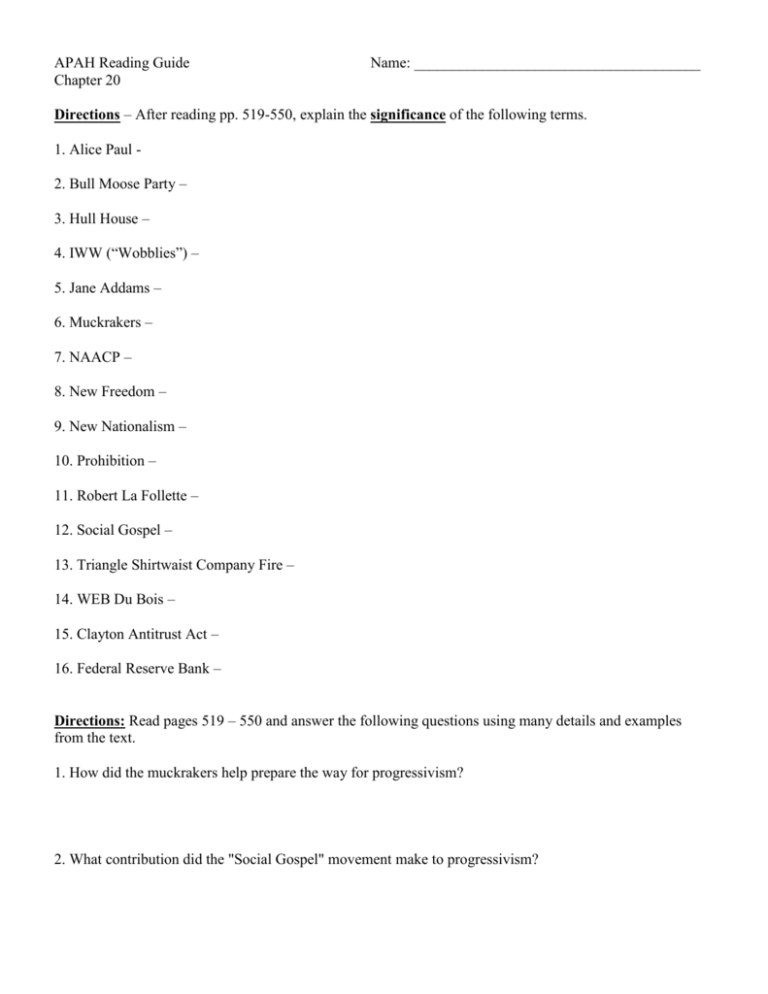
APAH Reading Guide Chapter 20 Name: ______________________________________ Directions – After reading pp. 519-550, explain the significance of the following terms. 1. Alice Paul 2. Bull Moose Party – 3. Hull House – 4. IWW (“Wobblies”) – 5. Jane Addams – 6. Muckrakers – 7. NAACP – 8. New Freedom – 9. New Nationalism – 10. Prohibition – 11. Robert La Follette – 12. Social Gospel – 13. Triangle Shirtwaist Company Fire – 14. WEB Du Bois – 15. Clayton Antitrust Act – 16. Federal Reserve Bank – Directions: Read pages 519 – 550 and answer the following questions using many details and examples from the text. 1. How did the muckrakers help prepare the way for progressivism? 2. What contribution did the "Social Gospel" movement make to progressivism? 3. How did the settlement house movement illustrate the progressive belief that the environment shaped individual development? What long-run effect did the movement have on reform? 4. Who was the so-called new middle-class? What was the role of expertise and organization in this new professionalism? 5. What was the role of women in the new professionalism? What were the characteristics of the professions dominated by women? 6. What socio-economic changes laid the foundation for the emergence of the so-called new woman? What were the characteristics of the new woman? 7. How did the women's club movement reflect both the growing political influence of women and the restrictions upon them? 8. What were the principal arguments for and against the woman's suffrage movement? Why did the movement inspire such passionate anti-suffrage sentiments? 9. What arguments and actions paved the way for suffrage's eventual triumph in the form of the Nineteenth Amendment? 10. Why were progressives so focused on reforming municipal government? What constituencies kept the so-called bosses in power? 11. What were the basic purposes of the initiative, the referendum, the recall, and the direct primary? How widely were they adopted? 12. What role did labor unions play in progressive reform? 13. By what means did some urban political machines, such as Tammany Hall, manage to survive the progressive era? 14. Why were western reformers particularly interested in action at the federal level even though much of the progressive movement focused on state and local legislation? 15. Compare and contrast the ideas of Booker T. Washington with those of W. E. B. Du Bois. What was the organizational result of the efforts of Du Bois and his allies? 16. Why did many progressives consider prohibition a vital reform? What forces combined to produce victory for prohibition in the Eighteenth Amendment? 17. Most progressives abhorred the urban disorder resulting from the influx of immigrants, but they differed about the appropriate response to the problem. What were the contrasting approaches? Which one dominated? 18. How did the socialist agenda differ from the typical progressive program? On what issues did the socialists disagree among themselves? Which view predominated? Why did socialism's already limited influence fade after 1918? 19. Describe the two different progressive approaches to the perceived problem of economic consolidation and centralization. What solutions did advocates of each approach favor? 20. How did Theodore Roosevelt become president? What was his main priority in his first years in office? 21. To what extent was Roosevelt a trust-buster? What was Roosevelt's view about how the federal government should deal with economic concentration? 22. How did Roosevelt's action in the 1902 oil strike differ from the typical role of the federal government in labor disputes? 23. How did Roosevelt's actions regarding railroad, food and drug, and meat regulations illustrate his cautious but progressive approach? 24. What was Roosevelt's position on conservation and the environment? How did it differ from the positions of previous presidents? 25. How did Roosevelt respond to the Panic of 1907? 26. Why did Roosevelt retire, even temporarily, from public life at the end of his second term? 27. Why was Taft so decisively defeated after only one term as president? 28. Describe the programs that Roosevelt unveiled at Osawatomie, Kansas. How did they go beyond the moderation he had exhibited as President? 29. Why did Roosevelt break from the Republicans to form the Progressive (Bull Moose) Party? 30. How did Roosevelt's New Nationalism and Wilson's New Freedom differ from each other as two brands of progressivism? 31. What propelled Wilson to victory in 1912? What roles did Taft and Eugene Debs play in the campaign? 32. What was the goal of the Underwood-Simmons tariff? How did it fulfill longstanding Democratic pledges? Why was a graduated income tax needed, as well as the tariff reduction? 33. How did the Federal Reserve Act transform the nation's monetary system? 34. Wilson pushed hard for the Federal Trade Commission Act and gave only lukewarm support to the Clayton Act. What do those actions demonstrate about his ironic move in the direction of New Nationalism? 35. After the initial spate of New Freedom legislation, how and why did Wilson back away from reform? What led him, later in his first term, to advance reform once again? 36. How did Theodore Roosevelt exemplify the modern presidency? 37. Did the Progressives ignore race? Why, or why not? Provide historical evidence to support your answer. 38. Should the Protestant Reform Movement be called the “Third Great Awakening?” Explain your answer. 39. Periodization: How did the Progressive Era differ from the Populism of the 1890s? Discuss whether or not these differences were sufficient to merit our looking at Progressivism as its own period in American history. Provide specific historical evidence to support your answer.

